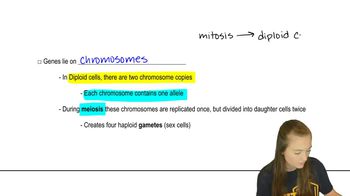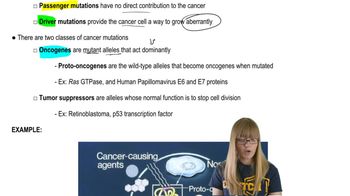Table of contents
- 1. Introduction to Genetics51m
- 2. Mendel's Laws of Inheritance3h 37m
- 3. Extensions to Mendelian Inheritance2h 41m
- 4. Genetic Mapping and Linkage2h 28m
- 5. Genetics of Bacteria and Viruses1h 21m
- 6. Chromosomal Variation1h 48m
- 7. DNA and Chromosome Structure56m
- 8. DNA Replication1h 10m
- 9. Mitosis and Meiosis1h 34m
- 10. Transcription1h 0m
- 11. Translation58m
- 12. Gene Regulation in Prokaryotes1h 19m
- 13. Gene Regulation in Eukaryotes44m
- 14. Genetic Control of Development44m
- 15. Genomes and Genomics1h 50m
- 16. Transposable Elements47m
- 17. Mutation, Repair, and Recombination1h 6m
- 18. Molecular Genetic Tools19m
- 19. Cancer Genetics29m
- 20. Quantitative Genetics1h 26m
- 21. Population Genetics50m
- 22. Evolutionary Genetics29m
17. Mutation, Repair, and Recombination
Types of Mutations
Problem 7
Textbook Question
Most mutations in a diploid organism are recessive. Why?
 Verified step by step guidance
Verified step by step guidance1
span>Step 1: Understand the concept of dominance and recessiveness in genetics. Dominant alleles express their traits even if only one copy is present, while recessive alleles require two copies to express their traits.</span
span>Step 2: Consider the genetic makeup of diploid organisms, which have two sets of chromosomes, one from each parent. This means they have two alleles for each gene.</span
span>Step 3: Recognize that mutations are changes in the DNA sequence. In diploid organisms, if a mutation occurs in one allele, the other allele can often compensate for the change, especially if the mutation is recessive.</span
span>Step 4: Explore the concept of loss-of-function mutations, which are often recessive. These mutations result in a non-functional protein, but if the other allele is normal, it can produce enough functional protein to maintain normal function.</span
span>Step 5: Conclude that most mutations are recessive because the presence of a normal allele can mask the effects of a mutated allele, preventing the mutation from affecting the organism's phenotype unless both alleles are mutated.</span
Recommended similar problem, with video answer:
 Verified Solution
Verified SolutionThis video solution was recommended by our tutors as helpful for the problem above
Video duration:
28sPlay a video:
Was this helpful?
Key Concepts
Here are the essential concepts you must grasp in order to answer the question correctly.
Diploid Organisms
Diploid organisms have two sets of chromosomes, one inherited from each parent. This means that for any given gene, there are two alleles present. The interaction between these alleles determines the organism's phenotype, with dominant alleles masking the effects of recessive ones.
Recommended video:
Guided course

Diploid Genetics
Recessive Mutations
Recessive mutations occur when a change in the DNA sequence leads to a non-functional protein or no protein at all. For a recessive mutation to manifest in the phenotype, both alleles of the gene must carry the mutation. This is why many mutations are considered recessive, as the presence of a dominant allele can mask their effects.
Recommended video:
Guided course

Cancer Mutations
Dominance and Phenotype Expression
Dominance refers to the relationship between alleles, where a dominant allele can mask the expression of a recessive allele in a heterozygous individual. This means that if one allele is dominant, the phenotype will reflect that dominant trait, while the recessive trait will only be expressed when both alleles are recessive, explaining why most mutations are recessive in diploid organisms.
Recommended video:
Guided course

Penetrance and Expressivity

 9:49m
9:49mWatch next
Master Point Mutations with a bite sized video explanation from Kylia Goodner
Start learning



